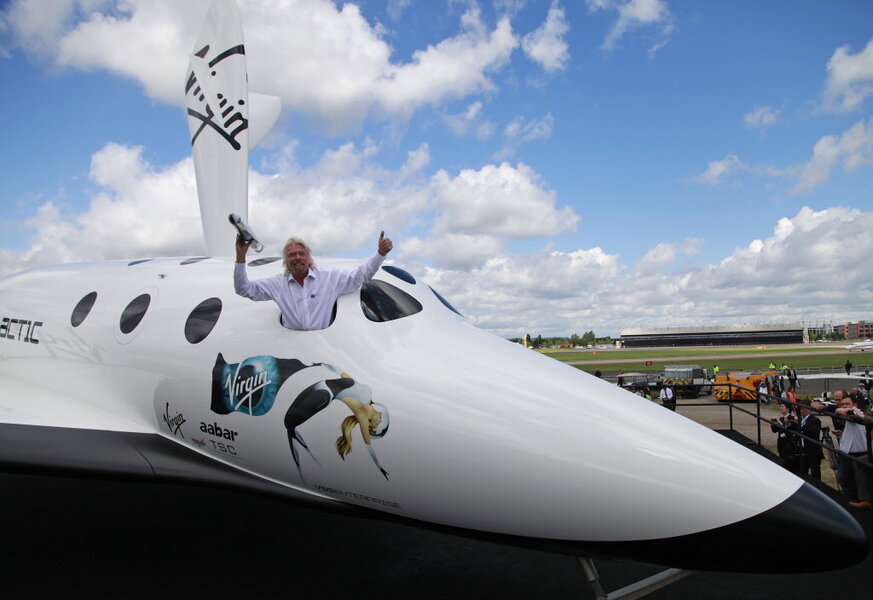Virgin Galactic edges closer to space in third rocket test flight
Loading...
Virgin Galactic’s would-be commercial spaceship has made its third rocket-powered, supersonic test flight, surpassing its previous height milestones and edging closer to its ambitions of boosting extremely well-paying customers into space.
SpaceShipTwo, Virgin Galactic’s supersonic spaceship, reached about 71,000 feet in its latest test flight on Friday, about 2,000 feet higher than its previous test flight in September.
It was the first time that Virgin Galactic pilot Dave Mackay commanded the plane in a rocket-powered flight, joining a test pilot from Scaled Composites, the company that develops Virgin Galactic’s spaceships. Scaled Composites test pilots had flown SpaceShipTwo’s previous rocket test flights.
SpaceShipTwo lifted off from California’s Mojave Air and Space Port under a WhiteKightTwo carrier jet at 7:22 a.m. local time. At around 46,000 feet, the spaceship was dropped from the carrier, ignited its engines, and burst to Mach 1.4. The rocket burn that carried the craft to 71,000 feet, near the middle of the Earth’s stratosphere, lasted just 20 seconds.
The test flight cleared the latest hurdle in British billionaire Sir Richard Branson’s race to make his company the world’s first space tourism outlet. The venture’s planned commercial start date is August 2014.
“I couldn’t be happier to start the New Year with all the pieces visibly in place for the start of full space flights," said Sir Richard, adding, "2014 will be the year when we will finally put our beautiful spaceship in her natural environment of space."
So far, Virgin Galactic has sold tickets at $250,000 a pop to Katy Perry, Brad Pitt, Angelina Jolie, and some 530 other buyers into what the company calls “perhaps the world’s most exclusive club.” NBC is on board to broadcast the company’s first official flight, on which Sir Richard and his two adult children have said they will be passengers, as well as to produce a space-themed reality show that gifts the winner a ride on SpaceShipTwo.
Champagne bottles have been clicked on SpaceShipTwo’s nose, Lady Gaga has said, though an anonymous source, that she’ll sing – at dawn, no less – inside the spaceship at maximum altitude sometime in 2015, and glossy promotional videos have drummed up excitement for what the company calls “the journey of a lifetime” and, simply, “the dream.”
Still, Virgin Galactic remains far from – specifically, 296,442 feet from – putting customers in bona fide space. The World Air Sports Federation defines space as beginning at what is called the Kármán line, 62 miles above Earth, and Virgin Galactic, working in tandem with Scaled Composites, has said that it is climbing toward that goal in a series of a test flights that each time aim higher and higher.
Scaled Composites has achieved those height goals before. SpaceShipTwo’s predecessor, SpaceShipOne, surpassed the Kármán line in 2004, soaring to 367,442 feet, or 69.6 miles, a feat for which it won its developer the $10 million Ansari X Prize that year. SpaceShipOne, though, was too small for the commercial market, with seating for just two passengers and one pilot. SpaceShipTwo accommodates six passengers and two pilots – plus, all passengers get their own pair of windows, out of which it will be possible to see the curvature of the Earth.
For at least one other space tourism outlet, though, the Kármán line is just inconvenient semantics. In October, a new commercial space venture, called World View, announced that it was swooshing into the high-flying tourism market with a business plan that puts a $75,000 price tag on a balloon-ride to the middle of the stratosphere, or about 19 miles above Earth. World View has scooted around the Kármán line problem by offering the “space environment" experience, not actual space.
World View has also billed its rides, in which customers will be buoyed upward in a capsule tethered to a giant parachute, as a more bucolic semi-space experience relative to Virgin Galactic's promises of supersonic speeds and zero gravity periods.
Both World View and Virgin Galactic will hub at the $209 million Spaceport America, a desert-girdled spaceport near Truth or Consequences, N.M., and the first spaceport to ever be built explicitly for commercial purposes.








